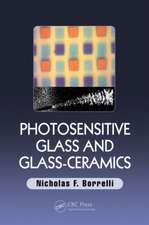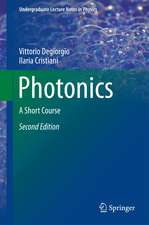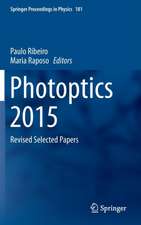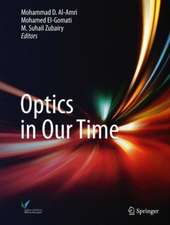Optical Solitons: Theoretical Challenges and Industrial Perspectives: Les Houches Workshop, September 28 – October 2, 1998: Centre de Physique des Houches, cartea 12
Editat de Vladimir E. Zakharov, Stefan Wabnitzen Limba Engleză Paperback – 10 aug 1999
Preț: 645.60 lei
Preț vechi: 759.54 lei
-15% Nou
Puncte Express: 968
Preț estimativ în valută:
123.55€ • 128.20$ • 103.27£
123.55€ • 128.20$ • 103.27£
Carte tipărită la comandă
Livrare economică 17-31 martie
Preluare comenzi: 021 569.72.76
Specificații
ISBN-13: 9783540663140
ISBN-10: 3540663142
Pagini: 404
Ilustrații: XVII, 384 p. 64 illus.
Dimensiuni: 155 x 235 x 21 mm
Greutate: 0.56 kg
Editura: Springer Berlin, Heidelberg
Colecția Springer
Seria Centre de Physique des Houches
Locul publicării:Berlin, Heidelberg, Germany
ISBN-10: 3540663142
Pagini: 404
Ilustrații: XVII, 384 p. 64 illus.
Dimensiuni: 155 x 235 x 21 mm
Greutate: 0.56 kg
Editura: Springer Berlin, Heidelberg
Colecția Springer
Seria Centre de Physique des Houches
Locul publicării:Berlin, Heidelberg, Germany
Public țintă
ResearchCuprins
Lecture 1 Fundamentals of Optical Soliton Theory in Fibers.- Lecture 2 Hamiltonian Theory of Bäcklund Transformation.- Lecture 3 Stability of Solitons.- Lecture 4 Chaotic Dynamics of Optical Solitons.- Lecture 5 Variationalism and Empirio-Criticism. (Exact and Variational Approaches to Fibre Optics Equations).- Lecture 6 Propagation of Optical Pulses in Nonlinear Systems with Varying Dispersion.- Lecture 7 Dispersion-Managed Solitons.- Lecture 8 Dispersion-Managed Solitons: Applications to Terabit/s Transmission over Transoceanic Distances.- Lecture 9 Nonlinear Pulses in Ultra-Fast Optical Communications.- Lecture 10 Soliton Wavelength-Division-Multiplexing System: From Numerical Design to Recirculating Loop Experiments.- Lecture 11 Mode-Locked Fiber Ring Lasers and Fiber Ring Memories.- Lecture 12 Modulational Instabilities in Passive Cavities: Theory and Experiment.- Lecture 13 Recent Developments in the Theory of Optical Gap Solitons.- Lecture 14 Vector Modulational Instabilities and Soliton Experiments.- Lecture 15 Transient Raman Amplification.- Lecture 16 Self-Structuration of Three-Wave Dissipative Solitons in CW-Pumped Optical Cavities.- Lecture 17 The Description of the Ultrashort Pulse Propagation in Non-Linear Media Under Quasi-Resonance Condition.- Lecture 18 Bright Spatial Soliton Interactions.- Lecture 19 Spatial Solitons in Saturating Nonlinear Materials.- Lecture 20 Discrete Solitons in Nonlinear Waveguide Arrays.- Lecture 21 Solitons in Cavities with Quadratic Nonlinearities.
Textul de pe ultima copertă
This book presents an overview of recent theoretical and experimental advances in the field of optical solitons, ranging from the mathematical foundations of integrability theory to the rapidly evolving technology of fiber soliton-based telecommunication systems. The subjects covered in the book can be broadly grouped into four main categories: optical soliton theory, fiber soliton telecommunications, optical soliton generation methods, and all-optical information processing via spatial solitons. This book should provide an interesting reference both for postgraduate students starting their research in the field, and researchers actively involved in nonlinear optics and optical communications.
Caracteristici
Includes supplementary material: sn.pub/extras



































